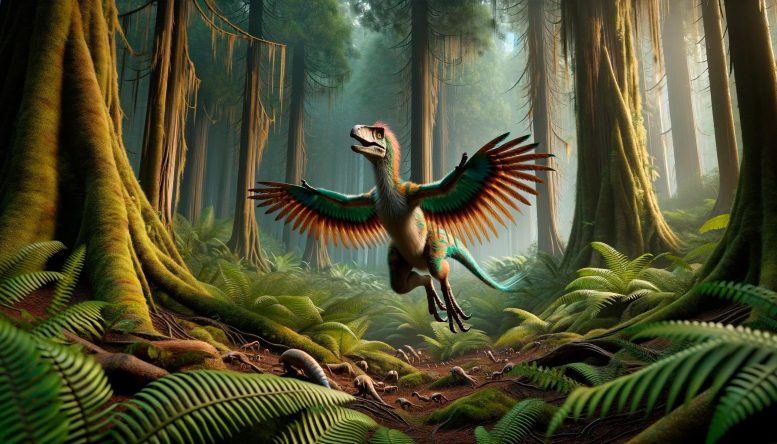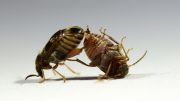
A study using a robot dinosaur named Robopteryx to mimic ancient dinosaur behaviors has provided new insights into the evolution of feathered wings. Researchers found that small, feathered proto-wings may have been used by dinosaurs to startle prey, supporting the hypothesis that such wings evolved for reasons other than flight. Credit: SciTechDaily.com
New research suggests feathered dinosaurs used proto-wings and tail feathers to flush out prey, supporting the ‘flush-pursue hypothesis’ for the evolution of bird wings and tails.
Small omnivorous and insectivorous dinosaurs may have flapped small, feathered primitive wings to scare prey out of hiding places, according to a study published in Scientific Reports. The authors built a robot dinosaur named Robopteryx to investigate how grasshoppers responded to different potential scaring behaviors, and speculate that the results could help explain why feathered wings evolved before they were capable of flight in some types of dinosaurs.
Discovery of Feathered Dinosaurs
Although the remains of numerous species of feathered dinosaurs have been discovered, so far only members of one group of dinosaurs known as Pennaraptora have been discovered with pennaceous feathers — the type of feathers required for flight. Fossils show that these developed first on small primitive or proto-wings that were not strong enough for flight and whose functions are currently unknown.
Hypothesis on Proto-Wings
Jinseok Park, Hyungpil Moon, Yuong‑Nam Lee, Sang‑im Lee, Piotr Jablonski, and colleagues hypothesize that the proto-wings may have been used for ‘flush-pursuit’ foraging, a hunting strategy observed in multiple species of contemporary insectivorous and omnivorous bird species such as the greater roadrunner (Geococcyx californianus) and the northern mockingbird (Mimus polyglottos). This strategy consists of predators using displays of contrasting-colored feathers on their wings and tails to startle prey out of hiding and into fleeing, at which point they can be pursued and caught.
This movie illustrates three different ways in which dinosaurs with proto-wings might have flushed their prey by visual displays to subsequently pursue them. First, the grasshopper jumps/flies away in response to expanding Robotperyx’s forelimbs with proto-wings. Second, the grasshopper jumps/flies away in response to folding of forelimbs with protowings. Third, the grasshopper escapes in response to upward movements of the tail.
Robopteryx Experiment
The authors built a robot named Robopteryx to test their hypothesis, basing it on the size, shape, and estimated movement range of the pennaraptoran dinosaur Caudipteryx — a two-legged, peacock-sized predator that lived approximately 124 million years ago. They then used Robopteryx to imitate several variations of flush-pursuit display behaviors — with the full sequence consisting of spreading the proto-wings and raising a tail, pausing with them outstretched, then folding them back — and observed the behavioral response of grasshoppers to the display behavior. Grasshoppers were used as they respond to flush-pursuit display behaviour and belong to the order Orthoptera which existed concurrently with Caudipteryx.
Robopteryx startles grasshoppers to flee in response to visual stimulation from the folding and spreading of forelimbs equipped with proto-wings, and in response to tail movements. The video shows the robot movements slowed down 12 times.
The authors found significant positive associations between the use of the proto-wings in the display behavior and both the likelihood of the grasshopper fleeing — with 93% of tested grasshoppers fleeing when the proto-wings were used compared to 47% without — and how far away Robopteryx was when they fled. They also found significant associations between both the presence of white patches on the proto-wings and the presence of feathers on the tail and the likelihood of the grasshopper fleeing.
Conclusions on Wing Evolution
The authors conclude that their results with Robopteryx support the flush-pursuit hypothesis, and provide a new perspective on why feathered wings and tails may have initially evolved in dinosaurs.
Reference: “Escape behaviors in prey and the evolution of pennaceous plumage in dinosaurs” by Jinseok Park, Minyoung Son, Jeongyeol Park, Sang Yun Bang, Jungmoon Ha, Hyungpil Moon, Yuong-Nam Lee, Sang-im Lee and Piotr G. Jablonski, 25 January 2024, Scientific Reports.
DOI: 10.1038/s41598-023-50225-x









It isn’t too surprising that grasshoppers would show a behavior of trying to flee when confronted by something resembling a bird — a modern-day predator.